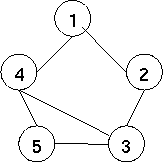| All Walks of length n from the first node |
A computer network can be represented as a graph. Let G = (V, E) be an
undirected graph, V =
![]() represents all nodes,
where m is the number of nodes, and E represents all edges. The first
node is v1 and the last node is vm . The number of edges is k. Define
the adjacency matrix
represents all nodes,
where m is the number of nodes, and E represents all edges. The first
node is v1 and the last node is vm . The number of edges is k. Define
the adjacency matrix
![]() where
where
An example of the adjacency matrix and its corresponding graph are as follows:
![$\textstyle \parbox{.5\textwidth}{
\begin{displaymath}
\left [
\begin{array}{ccc...
...
1 & 0 & 1 & 0 & 1 \\
0 & 0 & 1 & 1 & 0
\end{array}\right ]
\end{displaymath}}$](677img4.gif)

Calculate
The following example shows the walks of length 2.
![\begin{displaymath}A^2 = A \cdot A =
\left [
\begin{array}{ccccc}
0 & 1 & 0 & 1 ...
...\
0 & 1 & 1 & 1 & 1 \\
1 & 1 & 1 & 1 & 1
\end{array}\right ]
\end{displaymath}](677img8.gif)
Write programs to do above calculation and print out all distinct walks of
length n. (In this problem we let the maximum walks of length n be 5 and
the maximum number of nodes be 10.)
Separate the output of the different cases by a blank line.
5 2 0 1 0 1 0 1 0 1 0 0 0 1 0 1 1 1 0 1 0 1 0 0 1 1 0 -9999 5 3 0 1 0 1 0 1 0 1 0 0 0 1 0 1 1 1 0 1 0 1 0 0 1 1 0
(1,2,3) (1,4,3) (1,4,5) (1,2,3,4) (1,2,3,5) (1,4,3,2) (1,4,3,5) (1,4,5,3)